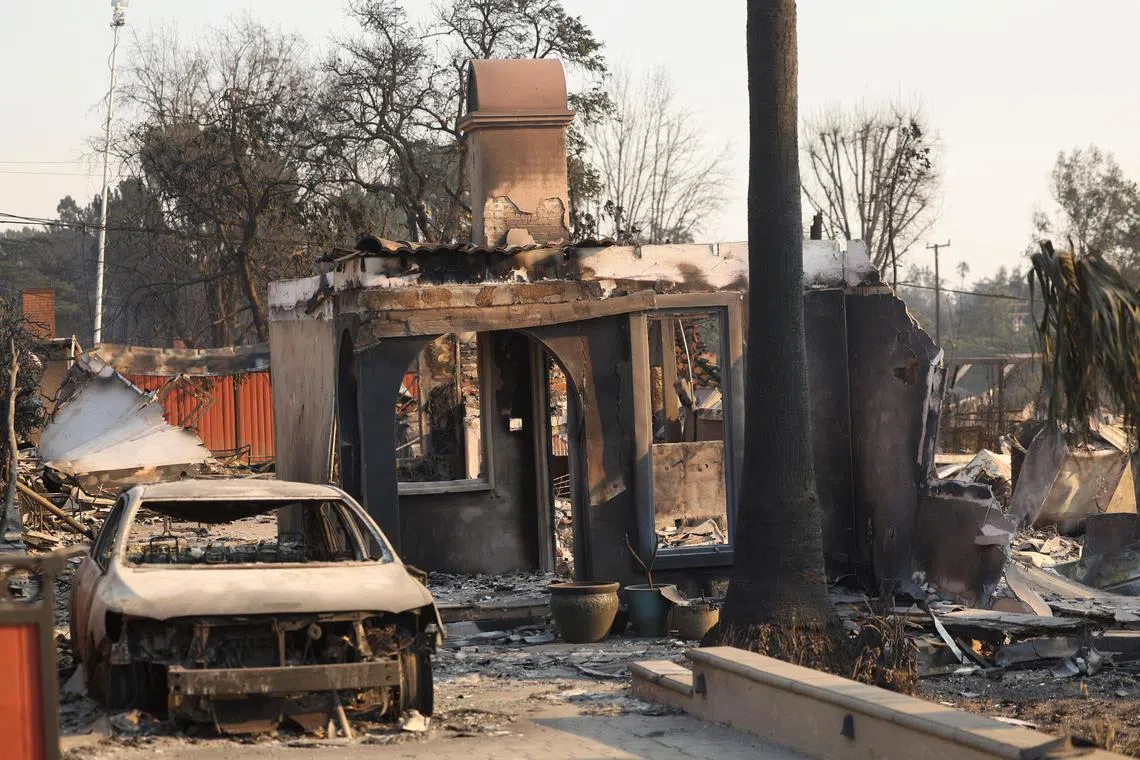Devastating LA fires expected to push up insurance premiums
Sign up now: Get ST's newsletters delivered to your inbox

Analysts estimated that the total cost of damage and insured damage had doubled in less than 24 hours.
PHOTO: REUTERS
Follow topic:
NEW YORK - The fires ravaging upmarket Los Angeles districts
Analysts at JPMorgan estimated that the total cost of damage and insured damage had doubled in less than 24 hours to US$50 billion (S$68.5 billion) and US$20 billion respectively.
And the flames were still advancing on several fronts on Jan 10.
These record levels already far outstrip the 2017 Tubbs fire and the 2018 Camp fire, whose estimates of insured damage have climbed to as much as US$16 billion, sources say.
The value of the houses makes all the difference: More than 10,000 buildings have been destroyed this week, the vast majority of them homes worth an average of US$3 million. By comparison, some 18,000 buildings were destroyed in the Camp fire in 2018, but the average house was worth only around US$500,000.
Mr David Burt, founder and director of DeltaTerra, a consultancy firm specialising in climate-related financial risks, estimates the market value of the 15,400 homes in Pacific Palisades to be close to US$13.5 billion.
Despite the high cost of the damage, experts believe insurance companies should have no problem compensating their customers.
According to Standard and Poor’s, the insurers are starting 2025 with comfortable reserves thanks to strong financial results over the last two years. They have also significantly reduced their presence in the Californian regions that are highly exposed to fire risk, and are well diversified.
The JPMorgan analysts see things the same way, insisting that, at this stage, it expects “the vast majority of losses stemming from the wildfires to be concentrated in home owners’ insurance”, and a “significantly lesser amount” in commercial fire and personal auto.
“There’s been a mass exodus of big players from the market in these parts of California,” Dr Ben Keys, a real estate and finance professor at the Wharton School of the University of Pennsylvania, said on Jan 10. “We’ve seen enormous non-renewals recently.”
On Jan 8, California’s insurance commissioner Ricardo Lara announced that home owners in areas affected by and around the fires would be protected for a year against non-renewal and cancellation of coverage.
This type of measure protected over a million contracts in 2024.
In 1968, the coastal state set up a public insurance scheme, called Fair, for home owners who could no longer find a private insurer.
This “band-aid” was meant to be temporary while people moved from one insurance policy to another, but has now expanded well beyond its intended use, lamented Dr Keys, noting that its exposure had risen from US$50 billion in 2018 to over US$450 billion today.
To bring companies back on board, Commissioner Lara has initiated a reform process authorising them to increase premiums on condition they do not apply any geographical exclusions.
There is no longer any question of “cherry-picking” to select the best contracts, said Dr Susan Crawford, an expert on climate and geopolitics at the Carnegie Endowment for International Peace.
“The acceleration in ferocious weather events... should trigger awareness that actually things do need to change,” she said. “We need some measure of political adjustments in reaction to rapid climate change.”
Meanwhile, Californians – and perhaps Americans nationwide – should prepare for higher premiums; 2025 has only just begun, and the previous year was marked by some destructive disasters.
Modelling by the specialist website AccuWeather shows hurricanes Milton and Helene caused US$160 billion to US$180 billion and US$225 billion to US$250 billion in damage respectively.
On Jan 8, it estimated the total cost of the Los Angeles fires so far at between US$135 billion and US$150 billion.
The State Department published a new national climate change strategy on Jan 10, stating that climate-related disasters like winter storms and hurricanes had caused US$182.7 billion in economic losses in 2024 – twice as much as in 2023. AFP

